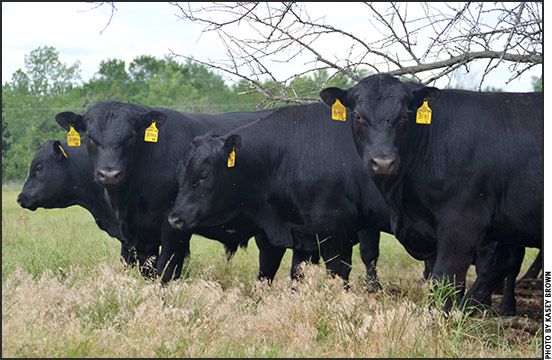
Buying bulls using data and discriminating visual appraisal may take longer. It might remind you of studying for a high school history test, but that extra study time for the test or bull purchase may reap a better price for your calves on sale day.

Ginette Gottswiller
The Source
Don’t gamble on your bull purchases. Understand the numbers behind them.
“If you buy a bull with narrow shoulders and a small head, you won’t ever pull a calf,” was a comment I heard the other day at the local auction barn. The next comment was: “My calves looked as good as that other set of black calves, but mine only brought $1.41, and his sold for $1.64. There wasn’t any difference; they weighed about the same and looked just like mine.”
Buying bulls on their “good looks” isn’t much different than going to a Las Vegas casino. The upside is you don’t have to do any homework. Just pay the producer and load them up. It may be a little risky come calving time — and even riskier when you sell your calves.
Buying bulls using data and discriminating visual appraisal may take longer. It might remind you of studying for a high school history test, but that extra study time in selecting a bull to buy may reap a better price for your calves on sale day.
Predictions
Let’s begin by looking at some expected progeny differences (EPDs). An EPD does not predict an actual weight or an actual measurement. The numbers are used to compare the predicted progeny performance of two bulls against each other. Here is an example using a weaning weight (WW) EPD.
- Bull A has a WW EPD of +66
- Bull B has a WW EPD of +55
Let’s say these two bulls will be used on a comparable cow herd that is managed about the same. You would expect Bull A’s calves to weigh an average 10 pounds (lb.) more at weaning time. (Bull A 66 lb. minus Bull B 55 lb. = 10 lb.)
Remember EPDs are a prediction, and cattle genetics aren’t that different than the genetics in my family. My dad has three brothers. The oldest was over 6 feet (ft.) 2 inches (in.) tall and of medium weight. The middle brother was 5 ft. 10 in. and heavy. Dad was the youngest, 6 ft. and medium weight.
The oldest brother had one son who was 5 ft. 7 in. and medium frame. The middle brother had two boys and two girls — all skinny as a rail and ranging from 5 ft. 2 in. to 5 ft. 7 in. Last was my dad. My brother and I are built almost alike: stout, medium frame and 5 ft. 8 in. and 5 ft. 10 in.
My point is if you line each of my cousins up, or even each group of siblings, you will find variation. Sometimes more than the prediction and other times less. There may even be an outlier like my son who is barely 5 ft. 6 in. and 120 lb. soaking wet. That does not mean someone lied about the data that was turned in. It does not mean the data does not work. It means it is a prediction. It may hit the bull’s-eye, or it may be on the last ring on the outside.
Accuracy
Next look at the accuracy of the EPD. Accuracy is the measurement of reliability. It is reported as a number between 0 and 1. The closer the number is to 1, the more reliable the EPD. As an example, let’s use Bull A above who is an artificial insemination (AI) bull (+66 for WW EPD) and his WW EPD accuracy is listed at 0.85. Your natural herd sire is Bull B, whose WW EPD was +55 and his accuracy is 0.30.
The American Angus Association publishes a table when a new sire summary comes out. View it at www.angus.org/Nce/Accuracy.aspx. This table gives the possible change (equivalent to 1 standard deviation) for each trait at different accuracy levels. Bull A’s accuracy of 0.85 equates to ±2.4 lb. So, two-thirds of the time, we would expect his +66 EPD could go up to +68 (66 + 2.4 = 68.4) or down to +64 (66 - 2.4 = 63.6).
Bull B on the other hand has a possible change value of ±11 lb. His true genetic value will fall somewhere between +66 and +44 two-thirds of time. Variation will always exist when breeding cattle, but the more accurate these EPDs are, the less risk you are assuming and the more confident you can be that your projected weaning weights will be on target. It isn’t that the numbers don’t work, but it is how to understand the numbers you have in front of you.
Documented value
Purchasing good genetics for your cow herd is one way to ensure your cows will take care of you over the long haul. Plus your feeder calves may bring more money than your neighbor’s calves. Enroll your feeder calves in AngusSource® and document the genetics of your bull battery. The Marketing Document shows the current EPDs of your bull battery and is emailed to more than 800 potential buyers. This gives those potential buyers an opportunity to see the genetic potential of your calf crop before sale day.
AngusSource is a low-cost third-party verification program for source, group age and at-minimum 50% Angus genetics. If you have been using quality genetics, find out how AngusSource can be a marketing asset to your operation this year. Contact the American Angus Association for more information on EPDs or to enroll in AngusSource at www.angus.org or 816-383-5100.
 Editor's Note: Ginette Gottswiller is the director of commercial programs for the American Angus Association.
Editor's Note: Ginette Gottswiller is the director of commercial programs for the American Angus Association.






